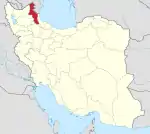Bileh Savar
Persian: بيله سوار | |
|---|---|
City | |
 Bileh Savar | |
| Coordinates: 39°22′40″N 48°20′59″E / 39.37778°N 48.34972°E[1] | |
| Country | |
| Province | Ardabil |
| County | Bileh Savar |
| District | Central |
| Population (2016)[2] | |
| • Total | 16,188 |
| Time zone | UTC+3:30 (IRST) |
| Bileh Savar at GEOnet Names Server | |
Bileh Savar (Persian: بيله سوار, also Romanized as Bilesuvar)[3] is a city in the Central District of Bileh Savar County, Ardabil province, Iran, and serves as the capital of the county.[4]
At the 2006 census, its population was 14,027 in 3,251 households.[5] The following census in 2011 counted 15,183 people in 4,033 households.[6] The 2016 census showed a population of 16,188 people in 4,837 households.[2]
The city is the site of a border crossing with Republic of Azerbaijan. Pile-Savar was built by a dignitary of the Buyid dynasty who was called Pile-Savar (the Great Rider).[7] Road 33 connects it to Ardabil.
References
- ↑ OpenStreetMap contributors (27 March 2023). "Bileh Savar, Bileh Savar County" (Map). OpenStreetMap. Retrieved 27 March 2023.
- 1 2 "Census of the Islamic Republic of Iran, 1395 (2016)". AMAR (in Persian). The Statistical Center of Iran. p. 24. Archived from the original (Excel) on 22 March 2019. Retrieved 19 December 2022.
- ↑ Bileh Savar can be found at GEOnet Names Server, at this link, by opening the Advanced Search box, entering "-3056417" in the "Unique Feature Id" form, and clicking on "Search Database".
- ↑ Habibi, Hassan (29 March 1370). "Creation and establishment of Qeshlaq District and Bileh Savar County in East Azarbaijan province". Lamtakam (in Persian). Ministry of Interior, Political-Defense Commission of the Government Board. Archived from the original on 28 November 2023. Retrieved 28 November 2023.
- ↑ "Census of the Islamic Republic of Iran, 1385 (2006)". AMAR (in Persian). The Statistical Center of Iran. p. 24. Archived from the original (Excel) on 20 September 2011. Retrieved 25 September 2022.
- ↑ "Census of the Islamic Republic of Iran, 1390 (2011)". Syracuse University (in Persian). The Statistical Center of Iran. p. 24. Archived from the original (Excel) on 15 January 2023. Retrieved 19 December 2022.
- ↑ Nāmah-ʼi bahāristān: Maǧallah-'i bayn al-milalî muṭālaʻāt va-taḥqīqāt nush̲ahā-yi h̲aṭtị̄ = international iranian journal for research into islamic manuscripts. Vol. IV. 2003-2004. Tihrān: Kitābhānah, Muzāh va markaz-i asnād maǧlis-i šawrā-yi islāmī. p.279.
This article is issued from Wikipedia. The text is licensed under Creative Commons - Attribution - Sharealike. Additional terms may apply for the media files.
